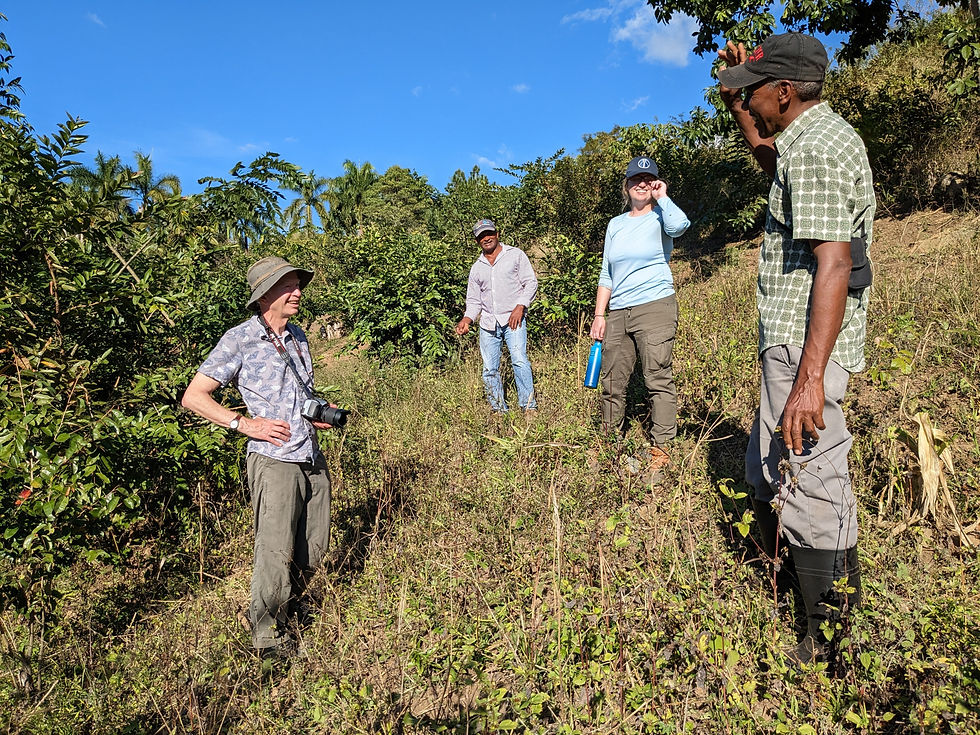Michaelanne's First Impressions of the Tree Bank
- Michaelanne Makuch
- Feb 9, 2023
- 3 min read

The journey started with a 4am wake up call, followed by a 12 hour layover at JFK and a midnight arrival to Santiago. Add another 3 hour drive and we finally arrived in Los Cerezos! As this was my first trip to the Dominican Republic, I wasn't sure what to expect, so I was excited to finally be able to see the lay of the land when the sun came up that morning. I soaked up the views while sipping on coffee and hot chocolate, waiting for our first busy day to officially begin.

On day one, our first stop was to the Tree Bank Nursery! In some ways, it's just like the Wild Plant Nursery at home with its rows of potted plants under shade cloth. But the plants themselves couldn’t be more different. Local-ecotype native tropical trees, coffee, and cacao were growing in tidy little rows waiting to be transplanted. The main difference between the Tree Bank Nursery and the Wild Plant Nursery, other than the species, is how much tidier the Tree Bank Nursery is! We then traversed the land of one of our associates, picking and eating oranges as we went. More visits, food, and juice rounded out a successful day one.
Before going any further, let me backtrack with a little background about the Tree Bank. The Earth Sangha has a partnership with the Asociación de Productores de Bosque Los Cerezos, a farmers’ cooperative in the mountains of the Dajabón province of the Dominican Republic, not far from the Haitian border. We operate a number of programs aimed at propagating local-ecotype native trees and conserving tropical forest, while promoting sustainable agriculture and helping to alleviate poverty.
A key part of our project is the Tree Bank Nursery where our colleagues and member farmers grow local-ecotype native trees, coffee, and cacao. Why are they growing coffee and cacao when they are not native to the region? Believe it or not, it's to protect the forest! All of our work in the Dominican Republic addresses two main components: conservation and economic uplift. The coffee and cacao are both shade crops, so they can be interplanted under the cover of native tree canopy. This way, not only are the farmers growing a good cash crop, but the forest is sure to be protected and won’t be cleared for cattle grazing. All trees from the Tree Bank Nursery are free for our member farmers. The idea is pretty simple: small-holder farmers can make some money while restoring threatened tropical forests.
The next few days involved evaluating restoration sites, visiting coffee and cacao plantings, meeting with member farmers, and being amazed at how fast trees can grow with such a long growing season! These young trees were already so big! The local flora really made me feel like I was living in a nature documentary, especially on sites that were flourishing, because it all looks so different from back home. There are still many areas that need help. Erosion, cattle grazing, and logging are taking a visible toll on the area. (We were also informed that a mining company was attempting to buy up land and extract precious minerals, which the locals were rather concerned about.) We discussed ways to increase the scale of reforestation projects, protect the land and community, and address inflation.
The hardest part of the trip? I only started learning Spanish in October! Equipped with a mere 3.5 months of Duolingo lessons, I certainly did a lot more listening than speaking, and was very glad to have Chris and Matt to act as translators. I'm really looking forward to the trips to follow, when I'll have a better grasp of the language to be a more active participant.
All in all, I think the trip was a great success! I learned a lot and had a great time doing it!
- Michaelanne Makuch
Conservation Coordinator

Recent Posts
See AllDear Friends, Just a few months ago I wrote how we will continue to focus on our conservation work – work that takes time to yield...



























Comments